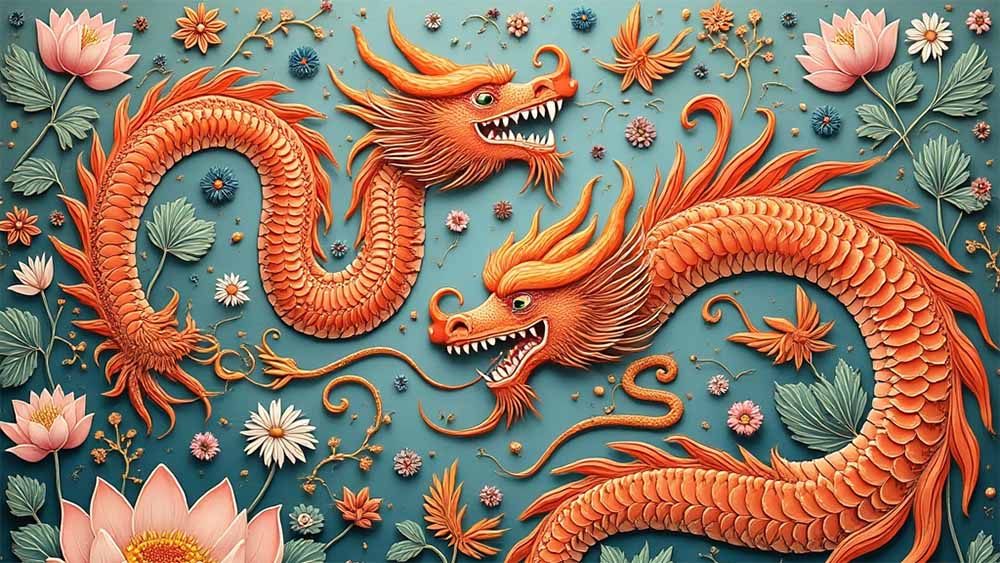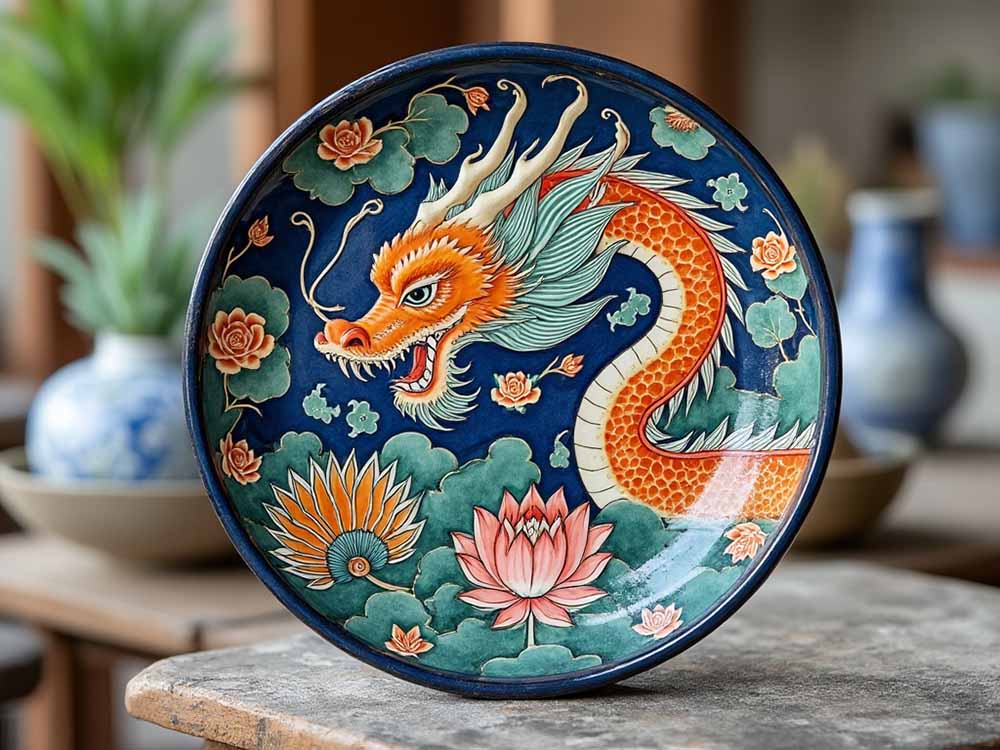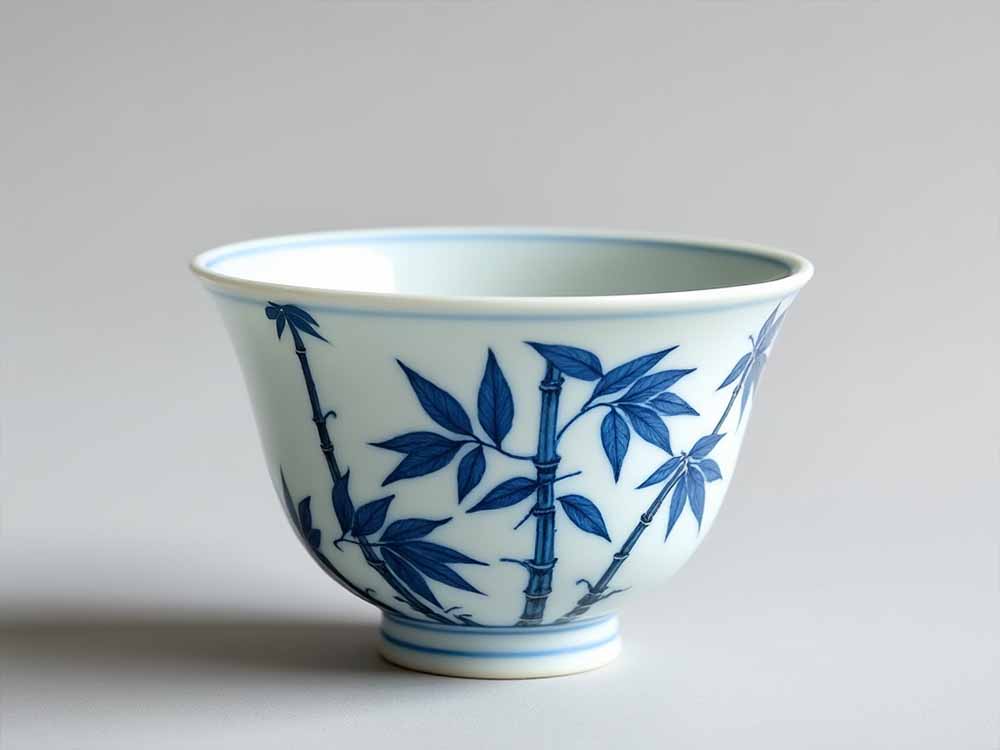Your cart is currently empty!

What Are The Different Patterns on Vietnamese Ceramics?
Vietnamese ceramics are a window into the fascinating country’s history, each one whispers stories of centuries gone by. Whether it’s a teapot with dragon scales or a plate with lotus flowers, the designs on Vietnamese ceramics mean more than just decoration. These designs aren’t just pretty, they’re part of Vietnamese DNA. So let’s dive into the various Vietnamese ceramics patterns, with a bit of fun and some expert advice from Southeast Asian ceramics expert, Rita Luu.
The Lotus: A Flower with Deep Roots
If there’s one design that’s most popular in Vietnamese ceramics, it’s the lotus flower. But this isn’t just any flower—this is a symbol of purity, resilience, and enlightenment. The lotus grows from the mud, yet remains unstained, a metaphor for staying pure and untainted despite life’s challenges. This design is often seen on bowls, vases, and dishes, its petals arranged in a way that invites contemplation.
Rita Luu, who’s spent more time around ceramics than most people spend on social media, says, “The lotus design is timeless. It’s more than just a floral motif; it’s a reflection of the Vietnamese spirit. Whenever I see it, I’m reminded of how beauty can emerge from even the most difficult situations.”

But the lotus design isn’t just painted on; it’s often carved or embossed, so you can touch as well as see. This technique is called “sgraffito” where you scratch through a surface layer to reveal a contrasting color underneath, giving the lotus a subtle yet striking 3D effect.
Historically the lotus design can be traced back to the Lý Dynasty (1009–1225) where it became a popular motif in Buddhist art and architecture. The dynasty’s adoption of Buddhism made the lotus a key decorative element not just on ceramics but also on temples and pagodas.
Dragons: Guardians of Tradition
What’s a Vietnamese ceramic without a dragon or two? Dragons in Vietnamese culture aren’t the fire-breathing, damsel-distressing kind you find in Western folklore. Here, they’re protectors, bringers of rain, and symbols of power. The dragon design on ceramics is as much a nod to ancient mythology as it is to Vietnamese belief in harmony and balance.
You’ll often see dragons wrapped around the rim of a pot or chasing a pearl across a bowl. Their curvy forms give the sense of movement and life as if they might just slide off the ceramic surface when you’re not looking. Rita laughs when I bring up the topic, “Every time I see a dragon design, I half expect it to wink at me. These designs have a playful yet profound quality – like they’re in on some ancient secret we’re only just starting to figure out.”

The dragon design is traditionally applied using underglaze techniques where the design is painted on the clay before it’s glazed and fired. This way the dragons remain vibrant even after centuries of use. During the Trần Dynasty (1225–1400) the dragon designs became more elaborate, reflecting the era’s fascination with mysticism and royal power.
Dragons on Vietnamese ceramics are different from Chinese dragons, with a more serpentine body and a fierce yet benevolent face. This is how Vietnamese artisans adapted the influence to make it their own. (You can learn more about the differences between Chinese and Vietnamese ceramics in this article.)
Bamboo: Strength and Flexibility
Another design you’ll see is bamboo; a symbol of strength, flexibility, and endurance. In Vietnamese culture bamboo is revered for its ability to bend without breaking, so it’s a powerful metaphor for resilience. Ceramics with bamboo designs give a sense of calm and stability, like a quiet grove swaying in the wind.
“Bamboo designs are my absolute favorite,” Rita says. “They’re simple yet powerful, a reminder that sometimes the most understated things in life are the strongest. Plus they look great on everything from tea cups to serving platters.”

Bamboo designs are often incised into clay or painted with quick, fluid brushstrokes so the plant’s movement and flow are captured and the design comes alive. Bamboo can be used on everyday items and more ornate pieces for special occasions.
Interestingly, bamboo designs aren’t exclusive to Vietnam, they can be found in other East Asian ceramics but in Vietnam the bamboo is often more stylized and abstract, reflecting the country’s artistic style.
Peonies: The Bloom of Prosperity
Peonies symbolize wealth, honor, and good fortune, often found on ceramics for special occasions like weddings or Tet, the Vietnamese New Year. The big, full blooms of the peony make a striking design, filling the surface with abundance and happiness.
In Rita’s words, “Peonies are the showstoppers of the ceramic world. Their symbolism and looks make them a must-have for any serious collector.” (And let’s be honest, who couldn’t use a bit of good luck?)

Peony designs are usually applied using the overglaze technique where the design is painted on top of the glaze and then fired at a lower temperature. This is a way to have the colors remain vibrant and distinct. During the Nguyễn Dynasty (1802–1945) peony motifs were the favorite of the royal court, symbolizing the dynasty’s wish for prosperity and longevity.
These floral designs can be found in other Asian ceramics as well but in Vietnam the peonies are often more full and exuberant, capturing the spirit of celebration and vitality of the peony.
The Phoenix: A Symbol of Renewal
In Vietnamese ceramics, the phoenix is a symbol of renewal and rebirth. The phoenix often goes with the dragon as together they represent yin and yang, balance and harmony. These pieces are both beautiful and full of cultural meaning.
“Whenever I see a phoenix design, I think of it as a reminder that every ending is a new beginning,” Rita says. “It’s a nice thought, especially when you’re sipping tea from a cup with this majestic bird.”

The phoenix is often shown with flowing feathers and a gentle pose, symbolizing elegance and virtue. This design is often found on ceramics for special occasions like weddings where the message of renewal is most relevant.
What about the Chinese phoenix? Well, in my opinion, the Vietnamese phoenix is more stylized and more elegant. This subtlety reflects the Vietnamese love for understated beauty and refinement.
The Cloud: A Journey Through the Skies
Clouds are a common motif in Vietnamese ceramics, often swirling around the edges of plates or vases. They represent the heavens and are thought to be the pathways for dragons and other celestial beings. The design is fluid and airy, adding a sense of lightness and movement to the ceramics (I think it makes them feel almost ethereal).
“Cloud designs are like little poems on ceramics. They remind us that there’s more to life than what we see—there’s always something beyond, just out of reach,” Rita adds.

Cloud designs are painted with quick brushstrokes, with many people comparing them to a dance. This technique is called “mài” where a thin, diluted glaze is used to achieve a soft, airy effect. The result is a design that floats on the ceramic surface, just like clouds in the sky.
In Vietnamese art, clouds have always represented the heavens, reflecting the country’s deep spiritual beliefs. This design is often painted with a dragon design, symbolizing the connection between the earthly and the divine.
Waves: The Rhythm of Life
And finally, we can’t talk about Vietnamese ceramics without mentioning the famous wave designs. These wavy patterns represent water, which is very important in Vietnamese culture. Water brings life, sustains communities, and is a metaphor for time. Wave designs are often found on large serving bowls or platters where the wavy lines add a dynamic element to the piece.
“Waves are all about movement and energy,” Rita says. “It’s a perfect metaphor for the ups and downs we all go through. And let’s face it, there’s something comforting about that repetitive wavy pattern. It’s like the ceramic version of a deep breath.”

The wave design is incised or painted with a steady hand, the flow is rhythmic and mimics the movement of water. During my research for this article, I found the design common in coastal areas where the sea is a big part of daily life. The waves also remind the coastal people of the impermanence of life and the importance of going with the flow.
Compared to wave designs in other Asian ceramics, the Vietnamese version is more abstract, it focuses on the movement rather than the literal water. This is how the Vietnamese people have learned to adapt and survive through the ups and downs of history.
Final Thoughts
Next time you see Vietnamese pottery, take a closer look. What seems simple at first glance might be hiding layers of meaning, history, and artistry. And who knows? You might just find a story that speaks to your journey.
If you liked this article, you can check out authentic Vietnamese ceramics and their designs at Clay and Leaf. Whether you’re adding to your collection or just starting, there’s something special about owning a piece that connects you to centuries of heritage and craftsmanship.
Thanks for reading.
Rita

Leave a Reply